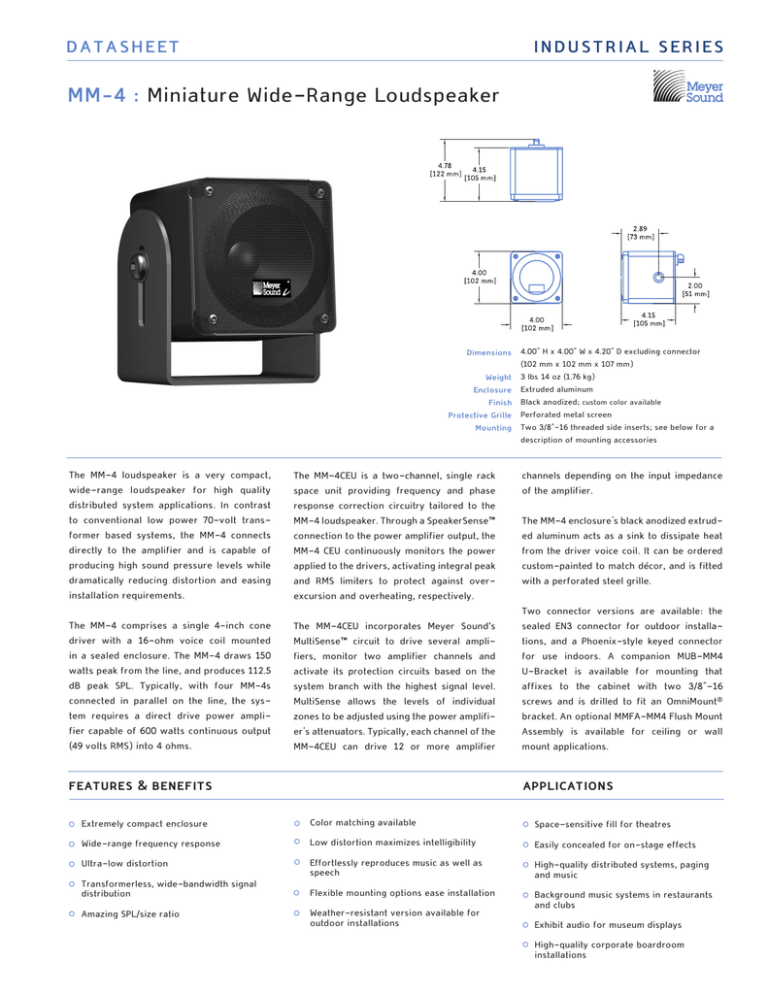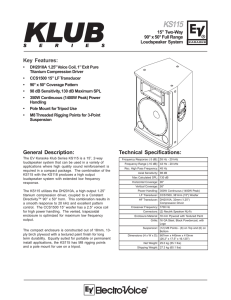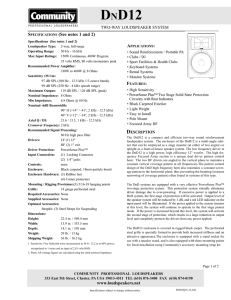
DATASHEET
INDUSTRIAL S ERI ES
MM-4 : Miniature Wide-Range Loudspeaker
Dimensions 4.00" H x 4.00" W x 4.20" D excluding connector
(102 mm x 102 mm x 107 mm)
Weight 3 lbs 14 oz (1.76 kg)
Enclosure Extruded aluminum
Finish Black anodized; custom color available
Protective Grille Perforated metal screen
Mounting Two 3/8"-16 threaded side inserts; see below for a
description of mounting accessories
The MM-4 loudspeaker is a very compact,
wide-range loudspeaker for high quality
distributed system applications. In contrast
to conventional low power 70-volt transformer based systems, the MM-4 connects
directly to the amplifier and is capable of
producing high sound pressure levels while
dramatically reducing distortion and easing
installation requirements.
The MM-4CEU is a two-channel, single rack
space unit providing frequency and phase
response correction circuitry tailored to the
MM-4 loudspeaker. Through a SpeakerSense™
connection to the power amplifier output, the
MM-4 CEU continuously monitors the power
applied to the drivers, activating integral peak
and RMS limiters to protect against overexcursion and overheating, respectively.
The MM-4 comprises a single 4-inch cone
driver with a 16-ohm voice coil mounted
in a sealed enclosure. The MM-4 draws 150
watts peak from the line, and produces 112.5
dB peak SPL. Typically, with four MM-4s
connected in parallel on the line, the system requires a direct drive power amplifier capable of 600 watts continuous output
(49 volts RMS) into 4 ohms.
The MM-4CEU incorporates Meyer Sound’s
MultiSense™ circuit to drive several amplifiers, monitor two amplifier channels and
activate its protection circuits based on the
system branch with the highest signal level.
MultiSense allows the levels of individual
zones to be adjusted using the power amplifier's attenuators. Typically, each channel of the
MM-4CEU can drive 12 or more amplifier
features & benefits
channels depending on the input impedance
of the amplifier.
The MM-4 enclosure's black anodized extruded aluminum acts as a sink to dissipate heat
from the driver voice coil. It can be ordered
custom-painted to match décor, and is fitted
with a perforated steel grille.
Two connector versions are available: the
sealed EN3 connector for outdoor installations, and a Phoenix-style keyed connector
for use indoors. A companion MUB-MM4
U-Bracket is available for mounting that
affixes to the cabinet with two 3/8"-16
screws and is drilled to fit an OmniMount®
bracket. An optional MMFA-MM4 Flush Mount
Assembly is available for ceiling or wall
mount applications.
applications
Extremely compact enclosure
Color matching available
Space-sensitive fill for theatres
Wide-range frequency response
Low distortion maximizes intelligibility
Easily concealed for on-stage effects
Ultra-low distortion
Effortlessly reproduces music as well as
speech
Transformerless, wide-bandwidth signal
distribution
High-quality distributed systems, paging
and music
Flexible mounting options ease installation
Amazing SPL/size ratio
Weather-resistant version available for
outdoor installations
Background music systems in restaurants
and clubs
Exhibit audio for museum displays
High-quality corporate boardroom
installations
MM-4 specifications
Acoustical1
Notes:
Operating Frequency Range2
Frequency Response3
Phase Response
Maximum Peak SPL4
Maximum Continuous SPL5
1. To realize the MM-4's full capabilities,
an MM-4CEU is required. The amplifier
driving the loudspeakers should be
capable of 49 volts RMS at the rated
load impedance, and provide a voltage
gain between 10 and 30 dB (20 dB for
optimal S/N ratio and protection). The
power rating of the amplifier should be
as follows:
1 MM-4/ch (16 Ω) 150 W
2 MM-4/ch (8 Ω) 300 W
4 MM-4/ch (4 Ω) 600 W
8 MM-4/ch (2 Ω) 1200 W
120 Hz - 18 kHz
160 Hz - 16 kHz ±4 dB
700 Hz - 17 kHz ±45°
112.5 dB
100 dB
Coverage
Horizontal
Vertical
Transducers
Low Frequency6
80° (3 kHz - 14 kHz ±10°); 120° (below 2 kHz)
80° (3 kHz - 14 kHz ±10°); 120° (below 2 kHz)
One 4" cone driver
Nominal impedance: 16 Ω
Voice coil size: 0.75"
Power-handling capability: 100 W (AES)7
2. Recommended maximum operating
frequency range. Response depends
on loading conditions and room
acoustics.
MM-4CEU Control Electronics Unit
Audio Input
Type
Maximum Common Mode Range
Connector(s)
Input Impedance
Wiring
DC Blocking
CMRR
RF Filter
Input Level
Differential, electronically balanced; RF and transient protected
±15 V DC, clamped to earth for voltage transient protection
Two female XLR, one for each input channel
10 kΩ differential between pins 2 and 3
Pin 1: Chassis/earth through 11 kΩ, 1000 pF, 15 V clamp network to
provide virtual ground lift at audiofrequencies; Pin 2: Signal +;
Pin 3: Signal -; Case: Earth ground and chassis
None
>60 dB, typically 80 dB (50 Hz - 1 kHz)
Common mode 850 kHz; differential mode 370 kHz
Maximum input voltage 25 V peak-peak (+21 dBu sine wave)
Audio Output
Type
Out Voltage
Connectors
Output Impedance
Wiring
<-90 dBV (A-weighted)
>115 dB
<0.01%, typically <.002%
<0.25 dB (20-20 kHz)
Controls
SpeakerSense Connectors8
Physical Dimensions
Weight
Finish
6. Aluminum enclosure dissipates heat
generated by driver.
Made by Meyer Sound, Berkeley, CA, USA
European Office:
Meyer Sound Germany
GmbH
Carl Zeiss Strasse 13
56751 Polch, Germany
IEC 320
Switch selectable on rear panel
90 - 130 V AC; 180 -260 V AC; 50/60 Hz
0.25 A max (rear panel T 250 mA fuse protected)
MM-4 - 04.091.033.01 B
Physical
LED Indicators
5. Measured at 1 meter, driven continuously for two hours with pink
noise signal having a 12.5 dB peakaverage ratio.
8. When using multiple sense lines,
all lines must be in same electrical
polarity.
AC Power
Connector
Voltage Selection
UL/CE Rated Voltage
Current Draw
4. Measured with pink noise at 1
meter.
7. Power handling is measured under
AES standard conditions: transducer
driven continuously for two hours
with band-limited noise signal having a 6 dB peak-average ratio.
Active push-pull, electronically balanced, capable of driving
600 Ω load; RF and transient protected
Maximum 50 V peak-peak (+27 dBu sine wave)
Two male XLR, one for each output channel
200 Ω differential between pins 2 and 3
Pin 1: Chassis/earth; Pin 2: Signal +; Pin 3: Signal -
Audio Performance
Hum and Noise
Dynamic Range
THD
Response Accuracy
3. Free field, measured with one-third
octave frequency resolution at 4
meters.
Sense Threshold/Gain Detect: (2) Red/Green LEDs, one per channel;
RMS Limiters: (2) Red LEDs, one per channel; Peak Limiters:
(2) Red LEDs, one per channel; Power: (1) Green LED
Front panel: (2) Rotary input attenuators, one per channel;
(2) Recessed low cut filter switches, one per channel;
(1) AC power latching push switch
Rear Panel: (1) AC voltage selector, recessed; (1) T250V fuse and holder
MultiSense, (4) dual banana, two per channel
19.00" W x 1.75" H x 7.75" D standard rack mount (482 mm x 44 mm x 197 mm)
8 lbs, 4 oz (3.74 kg)
Black, powder coated
Copyright © 2003
Meyer Sound Laboratories Inc.
All rights reserved
meyer sound laboratories inc.
2832 San Pablo Avenue
Berkeley, CA 94702
T: +1 510 486.1166
F: +1 510 486.8356
info@meyersound.com
www.meyersound.com
architect specifications
The loudspeaker system shall consist of a single 4" (102
mm) diameter cone transducer with a 100 watt (AES), 16ohm, long-excursion voice coil with air-cooled ceramic
magnet structure and mounted in a sealed aluminum
enclosure that provides heat sinking for the transducer’s
voice coil. The aluminum enclosure shall have exterior
dimensions of 4" (102 mm) wide by 4" (102 mm) high by
4.2" (107 mm) deep (including the grille but excluding the
connector) and it shall weigh 3 lbs 14 oz (1.76 kg). The
loudspeaker system shall produce continuous SPL of 100
dB at 1 meter with peak output of 112.5 dB at 1 meter
from 160 Hz to 16 kHz when used with the Meyer Sound
MM-4CEU Control Electronics Unit and a third-party
audio power amplifier. The power amplifier shall be a
professional grade, direct drive (transformerless output)
power amplifier determined to be capable of stable long
term output of 49 volts RMS (70 volts peak) at the rated
load impedance. The loudspeaker system shall be weather
resistant and suitable for sheltered outdoor applications
by virtue of an aluminum enclosure, special sealants,
watertight connector and chemically treated transducer
cone. The loudspeaker enclosure shall be fitted with a
3/8” threaded insert on two of the four sides to facilitate
installation and shall have a removable back plate for
driver servicing, secured with four Phillips screws.
The loudspeaker shall be the Meyer Sound MM-4 Miniature
Wide-Range loudspeaker.
The control electronics unit (CEU) shall be a single rack
space processor providing two separate channels with
frequency response optimization filters, phase alignment
and protection limiters specifically designed for the MM-4
loudspeaker system. The CEU shall provide RMS and peak
limiting to the audio signal feeding the power amplifier
when activated by a driver protection circuit that senses
the power amplifier output. The sensing circuit shall
allow each channel of the CEU to drive several power
amplifier channels and to sense two power amplifier
outputs at one time such that the highest level (voltage)
branch of an MM-4 distributed loudspeaker system will
not exceed the power handling of the drivers and will
actuate system protection circuits. A recessed frontpanel low cut boundary EQ filter switch shall be provided
for each channel to allow frequency compensation to
be applied when an optional subwoofer loudspeaker
is employed or for architectural/acoustic boundary
conditions. Each channel of the CEU shall provide a
rotary input attenuator, low cut filter toggle switch and
three LED indicators for signal level and sense threshold,
for the RMS limiter and for the peak limiter. An on-board
regulated power supply shall be included with externally
accessible fuse and all electrical parts shall be of the
highest quality.
The Control Electronics Unit shall be the Meyer Sound
MM-4CEU.



